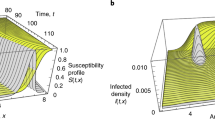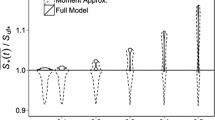Abstract
In this work we propose a variant of a classical SIR epidemiological model where pathogens are characterized by a (phenotypic) mutant trait x. Imposing that the trait x mutates according to a random walk process and that it directly influences the epidemiological components of the pathogen, we studied its evolutionary development by interpreting the tenet of maximizing the basic reproductive number of the pathogen as an optimal control problem. Pontryagin’s maximum principle was used to identify the possible optimal evolutionary strategies of the pathogen. Qualitatively, three types of optimal evolutionary routes were identified and interpreted in the context of virulence evolution. Each optimal solution imposes a different tradeoff relation among the epidemiological parameters. The results predict (mostly) two kinds of infections: short-lasting mild infections and long-lasting acute infections.








Similar content being viewed by others
References
Alizon S (2008) Transmission-recovery trade-offs to study parasite evolution. Am Nat 172(3):E113–E121
Alizon S, van Baalen M (2005) Emergence of a convex trade-off between transmission and virulence. Am Nat 165(6):E155–E167
Anderson RM, May RM (1982) Coevolution of host and parasites. Parasitology 85:411–426
André J-B, Ferdy J-B, Godelle B (2003) Within-host parasite dynamics, emerging trade-off, and evolution of virulence with immune system. Evolution 57(7):1489–1497
Bull JJ (1994) Perpective: virulence. Evolution 48(5):1423–1437
Cressler CE, McLeod DV, Rozin C, Van Den Hoogen J, Day T (2016) The adaptative evolution of virulence: a review of theoretical predictions and empirical tests. Parasitology 143(17):915–930
Day T (2001) Parasite transmission modes and the evolution of virulence. Evolution 55(12):2389–2400
Day T (2002a) The evolution of virulence in vector-borne and directly transmitted parasites. Theor Popul Biol 62(2):199–213
Day T (2002b) On the evolution of virulence and the relationship between various measures of mortality. Proc R Soc Lond B Biol Sci 269(1498):1317–1323
Ewald PW (1983) Host–parasite relations, vectors, and the evolution of disease severity. Annu Rev Ecol Syst 14:465–485
Frank SA (1996) Models of parasite virulence. Q Rev Biol 71(1):37–78
Herbert W (2000) The mathematics of infectious diseases. SIAM Rev 42(4):599–653
Jordan D, Smith P (2007) Nonlinear ordinary differential equations: an introduction for scientists and engineers. Oxford texts in applied and engineering mathemactics, 4th edn. Oxford University Press, Oxford
Mena-Lorca J, Hethcote HW (1992) Dynamic models of infectious diseases as regulators of population sizes. J Math Biol 30(7):693–716
Neilan RM, Lenhart S (2010) An introduction to optimal control with an application in disease modeling. Modeling paradigms and analysis of disease trasmission models (USA), DIMACS Series in Discrete Mathematics and Theoretical Computer Sciense, vol. 75, pp 67–82
Okubo A, Levin SA (2002) Diffusion and ecological problems: modern perspectives. Interdisciplinary Applied Mathematics. Springer, New York
Author information
Authors and Affiliations
Corresponding author
Additional information
Publisher's Note
Springer Nature remains neutral with regard to jurisdictional claims in published maps and institutional affiliations.
Appendix A: The Diffusion Term
Appendix A: The Diffusion Term
We assume that the pathogen is characterized by some (phenotypic) trait \(x\in [0,T]\) that can mutate. The mutation process is modeled according to a random walk with steps of length \(\delta x > 0\).
Let v(t, x) denote the density of infectious hosts with pathogen of trait x at time t. We want to describe the time evolution of v(t, x). Let \(p\in [0,1]\) be the probability that an infective host transmits a mutant pathogen. If h denote an infinitesimal time, then (see Fig. 9)
Rearranging the terms
Assuming that \(\beta (x)\) and v(t, x) are analytic functions, the Taylor’s series expansion for the product \(\beta (x)v(t,x)\) implies, for \(\delta x\) small, that Eq. (17) can be approximated by
In the limit (\(h \rightarrow 0 \)), taking into account demographic variation, we obtain
where \(D = \frac{p(\delta x)^2}{2}\). The Neumann boundary conditions
are imposed.
Rights and permissions
About this article
Cite this article
Silva, E.J.A.d., Castilho, C. Optimal Virulence, Diffusion and Tradeoffs. Bull Math Biol 82, 16 (2020). https://doi.org/10.1007/s11538-019-00688-9
Received:
Accepted:
Published:
DOI: https://doi.org/10.1007/s11538-019-00688-9





